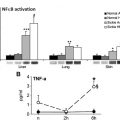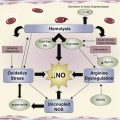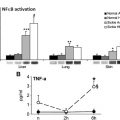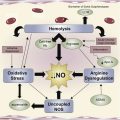P-selectin on endothelial cell surfaces is central to impaired microvascular blood flow in sickle cell disease (SCD). Restoration of blood flow is expected to provide therapeutic benefit for SCD patients, whatever the mechanism of action of the treatment. Long-term oral administration of a P-selectin–blocking agent potentially improves blood flow and averts acute painful vaso-occlusive crises in patients with SCD. This review focuses on the pathophysiology of the impairment of microvascular blood flow in SCD with an emphasis on the role of P-selectin and summarizes the status of development of antiselectin therapies as a means of improving microvascular flow.
Key points
- •
Impaired blood flow is the ultimate morbid effect of the canonical sequence deoxygenation → sickle hemoglobin polymerization → erythrocyte sickling.
- •
Adhesion of sickle red blood cells to the vascular endothelium has been shown to initiate acute vascular occlusion; numerous polymerization-dependent and polymerization-independent mechanisms contribute to its completion.
- •
Effective correction of abnormal blood flow acting through any mechanism will provide therapeutic benefit.
- •
Endothelial P-selectin is initiatory and necessary for adhesion of sickle red blood cells to the endothelium.
- •
Although several selectin-blocking drugs are in their development phase, an orally active agent is preferable for long-term, prophylactic therapy.
Introduction
The importance of P-selectin to the pathophysiology of sickle cell disease (SCD) is understood through its effect on blood flow. P-selectin is central to the abnormal blood flow in SCD, and abnormal blood flow is paramount to the morbidity and mortality of the disorder. Although the expression of P-selectin makes important contributions to normal platelet activity, hemostasis, coagulation, and inflammation, the focus of this review is the detrimental effect of endothelial P-selectin–mediated sickle red cell adhesion on sickle cell blood flow.
Introduction
The importance of P-selectin to the pathophysiology of sickle cell disease (SCD) is understood through its effect on blood flow. P-selectin is central to the abnormal blood flow in SCD, and abnormal blood flow is paramount to the morbidity and mortality of the disorder. Although the expression of P-selectin makes important contributions to normal platelet activity, hemostasis, coagulation, and inflammation, the focus of this review is the detrimental effect of endothelial P-selectin–mediated sickle red cell adhesion on sickle cell blood flow.
Abnormal blood flow in sickle cell disease
Abnormal blood flow is responsible for most of the morbidity associated with SCD. Stroke, acute painful episodes, splenic sequestration and infarcts, osteonecrosis, acute chest syndrome, and priapism are among the clinical events caused by or significantly contributed to by impaired blood flow. Stroke is an important cause of disability and death ; pain crises are major determinants of the quality of life and have been associated with increased mortality. In this regard, deficient blood flow can be regarded as the principal defect of SCD.
Microvascular blood flow has been found to be consistently abnormal in sickle cell patients even when they are not experiencing pain crises, independent of the technique used for measurement (nail-bed microscopy, laser Doppler measurement, or ocular computer-assisted intravital microscopy). During acute pain crises, additional flow changes are detected using these same methods.
The contribution of numerous polymerization-independent processes to impaired sickle cell blood flow provides several therapeutic targets for remedying abnormal sickle cell blood flow as alternatives to unraveling the paradigmatic Gordian knot of deoxygenation → sickle hemoglobin (HbS) polymerization → sickle red blood cell (SRBC) rigidification and sickling. This understanding suggests that genetic diseases do not necessarily require genetic treatments. The primacy of abnormal blood flow to these complex interrelated pathophysiologies is revealed by the dependence of polymerization-independent mechanisms on ischemia/reperfusion.
Determinants of sickle cell blood flow
The flow of sickle cell blood is influenced by classical descriptors of Newtonian fluid flow, as well as by additional determinants that pertain to its non-Newtonian nature, unique properties as sickle cell blood, and exogenous influences to which it is singularly susceptible. The relative influences of these myriad factors vary in different parts of the circulation and variable conditions affecting those vessels.
It has been reasoned that blood viscosity is a more important determinant of blood flow in large vessels and that individual SRBC deformability is of greater consequence to microcirculatory flow, and that this accounts for the contrasting clinical effects of RBC transfusion that differ according to the conflicting influences on the two circulations. In this analysis the importance of SRBC folding to squeeze through small vessels is paramount in the microcirculation where rigidification of SRBC is highly detrimental. Most critical to the present discussion, the tight squeeze of flowing cells through the smallest vessels exposes the entire circumference of these cells to endothelial cell adhesion molecules, which renders microcirculatory flow more susceptible than large-vessel flow to the detrimental effects of cell adhesion. This concept was illustrated clearly by Hebbel, as shown in Fig. 1 .

Importance of SRBC adhesion to blood flow
Awareness of the potential importance of SRBC adhesivity to microcirculatory blood flow began with the initial reports of abnormal SRBC adhesivity to cultured endothelial cells in comparison with normal RBC. Evidence for the clinical importance of this adhesion followed promptly, with the determination that the degree of SRBC adhesivity correlates with vaso-occlusive severity of disease. It subsequently was demonstrated that acute vaso-occlusion occurs as a 2-step process initiated by the adhesion of a stickier subset of SRBC and completed by the physical trapping of a more rigid, polymerization-prone subset. In these studies, human SRBC were separated according to density and fractions studied in an ex vivo rat mesocecum flow system, in which intravital microscopy was used to assess the adherence of SRBC and the pressure resistance units were measured to detect flow obstruction in the microcirculation. Infusion of low-density SRBC resulted in adherence but not obstruction of flow; infusion of high-density SRBC resulted in neither adherence nor obstruction of flow; and sequential infusion of low-density followed by high-density SRBC resulted in both adherence and obstruction of flow. This discovery suggested that the preceding 79 years of sickle cell research had been focused on the second step of vaso-occlusion and established SRBC adhesion as a valid initial target for sickle cell research and therapy. In this regard, therapies that abrogate SRBC adhesion have a major impact on SRBC flow in vitro, ex vivo, in mouse models of SCD, and in patients with SCD. The chronic expression of an SRBC-binding adhesion molecule, P-selectin, on the vascular endothelium in sickle cell mouse models and human endothelial cells from sickle cell patients supports the notion that adhesion-mediated chronic drag on SRBC flow might account for the chronically abnormal microcirculatory blood flow in animal models and patients with SCD.
Cellular mechanisms of SRBC adhesion
Based on results from experiments using bone marrow transplantation of sickle cell mouse bone marrow to C57BL control mice and aggressive methods of endothelial activation with high doses of tumor necrosis factor (TNF)-α in vivo, it was concluded that leukocyte adhesion to the endothelium precedes and mediates SRBC adhesion. Follow-on considerations posited that heterocellular aggregates also contribute to abnormalities of blood flow. The possible relevance of these adhesion mechanisms to blood rheology notwithstanding, direct adhesion of SRBC to the endothelium independent of leukocytes is well established in the vascular perturbation of SCD, and argues against the hypothesis that leukocyte adhesion must precede SRBC adhesion.
Molecular mechanisms of cell adhesion
The process of leukocyte adhesion to the endothelium during the inflammation is understood in great detail and serves as a model for deciphering SRBC adhesion to endothelial cells. Pioneering studies disclosed that during inflammation leukocyte adhesion uses a cascade of adhesion molecules, triggered by initial contact with selectins and completed by firm adhesion to molecules of other types. Among the selectins, P-selectin has been found to be initiatory in the adhesion cascade, predominant over the other selectins, and essential for a complete inflammatory response. Downstream molecules that mediate firm adhesion and transendothelial migration of leukocytes are members of the integrin family and immunoglobulin superfamily. Those molecules have considerable overlap in their function, which makes it unlikely that absence or inhibition of any one of these would abrogate their aggregate function. These considerations define P-selectin as the initiatory linchpin molecule for leukocyte adhesion to the vascular endothelium.
The selectin family of cytoadhesion molecules consist of P-selectin, E-selectin, and L-selectin, each of which mediates cytoadhesion through Ca 2+ -dependent recognition of specific cell surface carbohydrates. P-selectin requires fucose and sialic acid in its recognition determinant; its glycan ligand, PSGL-1, has sialyl Lewis X (sLeX) in close proximity to sulfated tyrosine near the amino terminus of the ligand. Adhesion by any of the selectins requires hydrodynamic shear stress and is nonexistent in the absence of flow. Expression of P-selectin on the surface of platelets and endothelial cells requires their activation. The prompt translocation of P-selectin from α storage granules within platelets to the cell surface is induced by the rapid-acting secretagogue thrombin ; thrombin, histamine, complement components, oxygen radicals, phorbol esters, calcium ionophores, hypoxia, hypoxia/reoxygenation, and heme induce the rapid translocation of P-selectin from the Weibel-Palade body storage granules in endothelial cells to the surface of those cells. Constitutive transcription of P-selectin within endothelial cells supplies Weibel-Palade bodies with the molecule, and induction of more rapid transcription may overload the Weibel-Palade bodies, resulting in chronic surface expression of P-selectin.
Initial reviews of the therapeutic potential of blocking SRBC adhesion did not include a molecular cascade mechanism, as selectins had not been tested for SRBC adhesivity. Subsequent studies established that endothelial P-selectin mediates abnormal static adhesion and rolling adhesion of SRBC in vitro, as shown in Fig. 2 , and that this SRBC adhesion to endothelial P-selectin can be prevented in vitro using approved P-selectin–blocking therapeutic agents. Induction of endothelial P-selectin expression with an N-terminal peptide of protease-activated receptor-1, which selectively activates mouse endothelial cells but not mouse platelets, triggered prompt SRBC adhesion and acute stoppage of blood flow in the microcirculation of sickle cell chimeric mice. These in vivo adhesion studies were rigorously controlled by use of a combination of leukocyte adhesion–blocking antibodies, tagging leukocytes with rhodamine 6G, and careful visual and video monitoring for leukocyte adhesion, which established that leukocyte adhesion was not involved in the SRBC adhesion measured. Preliminary attempts to identify the ligand for P-selectin on SRBC detected no PSGL-1, abnormally increased amounts of sLeX, and an absolute dependence on sLeX for SRBC rolling on immobilized P-selectin, whether the sLeX was on glycolipids or O-linked, N-linked, or PI-linked glycoproteins. Numerous other adhesion molecules also have been described as participants in SRBC adhesion, which is in accordance with multifactorial completion of SRBC adhesion. The initiatory role of P-selectin in SRBC adhesion to the endothelium suggests a strong therapeutic potential for blocking this molecule.
Chronic expression of endothelial P-selectin in SCD
The rapid transfer of P-selectin to the surface of endothelial cells and initiatory role of P-selectin in SRBC adhesion together suggest a role for endothelial P-selectin in acute vaso-occlusion; the chronic endothelial expression of P-selectin on the endothelium in sickle cell mouse models and circulating endothelial cells in human SCD patients has entirely different rheologic implications. Persistent endothelial presentation of P-selectin likely accounts for the slower microcirculatory flow velocity in sickle cell chimeric mice with sickle cell mouse hosts compared with chimeras with P-selectin knockout mouse hosts, as shown in Fig. 3 . In addition, intravenous administration of subanticoagulant but P-selectin–blocking doses of heparin to patients with SCD resulted in an immediate and prolonged increase in blood-flow velocity. This evidence from animal SCD models and human SCD patients of endothelial P-selectin causing a chronic drag on microcirculatory flow, a circulation particularly susceptible to the influence of adhesion processes, has been challenged by the notion that human endothelial cells are incapable of transcriptionally regulated expression of P-selectin. That claim is based on results using tumor necrosis factor α, interleukin-1β, or lipopolysaccharide as human endothelial cell agonists. Because P-selectin transcription in human endothelial cells is driven successfully by interleukin-3, interleukin-4, or oncostatin M, a group of cytokine agonists that also are germane to SCD, this challenge does not invalidate the concept that chronic P-selectin expression on human endothelium slows microcirculatory SRBC flow in SCD patients. Moreover, persistent cycling of P-selectin translocation, endocytosis, and reexpression on the cell surface can be driven by rapid-acting P-selectin agonists, such as thrombin and reactive oxygen species (ROS), which are increased in patients with SCD. Moreover, the adhesion of SRBC to endothelial cells results in increased levels of ROS within the endothelial cells, and increased ROS within endothelial cells upregulates the expression of P-selectin on the cell surface. In this regard, the mere act of SRBC adhesion creates a positive feedback cycle of SRBC-endothelial adhesion. Detectable evidence of this perturbation evolves from the increased transcription of soluble vascular cell adhesion molecule 1 (sVCAM-1) resulting from the increased endothelial ROS, and the predicted increased plasma levels of sVCAM-1.
P-selectin on the microvascular endothelium of patients with SCD presents an opportunity for therapeutic intervention.
Therapeutic and commercial potential of P-selectin blocking
The foregoing discussion presents a coherent background for the application of adhesion-blocking agents for the treatment of SCD. Antiadhesion therapy is also justified by numerous reports and reviews on the subject, and by inclusion of this mechanism in discussions of other therapeutic strategies such as overcoming arginase effects, improving redox abnormalities with l -glutamine, and the use of statins or nitric oxide. The commercial potential in the sickle cell space is demonstrated by the recent exclusive licensing agreement between Pfizer and Glycomimetics worth up to $340 million for a selectin-blocking agent, exclusive option for Novartis to acquire Selexys and their P-selectin monoclonal antibody for $665 million, and the $47 million investment by Third Rock Ventures in Global Blood Therapeutics.
Considerations for development of antiadhesion therapies
Considerations for the development of pharmaceutical agents include the therapeutic target and route of delivery for new agents. A basic decision for developing antiadhesion agents for SCD therapy is whether to treat vaso-occlusive pain crises or prevent them. The multiple mechanisms involved once vaso-occlusion is completed argue against the use of a monospecific adhesion-blocking agent for the treatment of established pain crises. Based on this thinking, another cautionary argument can be made against the use of agents that block only the initiatory molecules, the selectins, for the treatment of established pain crises. The dependence of selectin adhesivity on shear stress suggests that blocking these molecules for the treatment of an event caused by stoppage of blood flow has questionable potential. Treatment of established pain crises with a nonspecific adhesion blocker would redress more of the adhesive processes that initiate vaso-occlusion, but an effect on the physical trapping of rigid SRBC is unlikely. Testing the efficacy of agents that target the treatment of established SCD pain crises uses measurements of the duration and intensity of pain, duration of hospitalization, and opioid use.
The use of antiadhesion therapy for prophylaxis of pain crisis has much to recommend it, particularly blocking P-selectin, which is chronically expressed and initiates acute vaso-occlusion. A possible exception to targeting only selectins for prophylaxis of vaso-occlusion derives from a study in sickle cell mice in which platelet-activating factor–induced SRBC adhesion and vaso-occlusion was prevented by pretreatment with a monoclonal antibody against αVβ3 integrin. To the extent that leukocyte-endothelial adhesion and heterocellular aggregates contribute to impaired blood flow, both processes involve P-selectin–mediated adhesion, which suggests that their possible detrimental effects would likely be overcome by P-selectin–blocking drugs.
Regarding routes of administration, parenteral administration is well suited for inpatient treatment of pain crises, but less so for outpatient pain management. Prophylactic therapy is necessarily conducted in an outpatient setting, the success of which is strongly dependent on patient adherence. Patients prefer oral administration to injections or infusions for outpatient therapy, and programs for enhancing patient adherence to oral outpatient therapy have been developed. Patients adhere more to once-daily oral therapy than to divided oral doses. Testing the efficacy of antiadhesion agents used for the prophylaxis of SCD pain crises uses measurements of the frequency of pain and possibly also of daily pain scores, health care utilization, opioid use, microvascular blood flow, and markers of vascular injury. In the last regard, the plasma level of sVCAM-1 is an especially sensitive and robust marker for antiadhesion agents, as blocking SRBC adhesion to endothelial cells reduces levels of ROS within endothelial cells and consequent P-selectin on endothelial cell surfaces and VCAM-1 synthesis.
Antiadhesive agents under development or consideration for treating SCD
Several antiadhesive agents have been created for use in treating SCD, and other P-selectin blockers have such potential.
GMI-1070 is a small molecule glycomimetic compound that was synthesized using a rational design strategy intended to block selectin-mediated adhesion. This compound, which must be administered by injection, is being applied to the treatment of established acute pain crises in patients with SCD. The drug inhibits adhesion of sLeA or sLeX to E-, P- and L-selectins with IC 50 s of 4.3, 423, and 337 mM, respectively. Its negligible effect on P-selectin may be a consideration for this drug if leukocyte adhesion is important to vaso-occlusion, because it has been shown in a mouse SCD model that leukocyte-endothelial adhesion is mediated by P-selectin but not E-selectin. GMI-1070 had no detectable effect on blood flow in patients with SCD. A phase 2 clinical trial with end points of reducing the severity and duration of pain crises and duration of hospitalization was encouraging, and the drug will therefore undergo phase 3 study.
SelG1 is a humanized P-selectin monoclonal antibody that has a t 1/2 in the circulation of 2 weeks. It must be administered intravenously. SelG1 is being applied to the prophylaxis of acute pain crises in patients with SCD. No phase 1 results are available as of the time of this writing. A multicenter phase 2 trial is being planned, in which the drug will be administered as a 100-mL infusion monthly for 1 year, with an end point of reducing the frequency of pain crises.
MST-188 is a nonionic block copolymer surfactant that binds to hydrophobic surfaces of damaged cells to block cell-cell adhesion through a broadly specific mechanism. It is administered by 48-hour intravenous infusion and is being applied to the treatment of established acute pain crises in patients with SCD. Results from a phase 3 clinical trial demonstrated improved microvascular blood flow and more rapid resolution of pain crises in comparison with placebo, particularly in children. This drug will undergo a second phase 3 trial in pediatric SCD patients.
Heparin is an injectable anticoagulant that had been in the clinic for decades before it was found to have effective P- and L-selectin–blocking activity. Subsequent studies revealed that unfractionated heparin blocked L-selectin at concentrations one-tenth that of anticoagulant concentrations, and P-selectin at one-tenth yet lower concentrations. Thus there is a large therapeutic window that avoids hemorrhagic risks. These studies also revealed that unfractionated heparin had 100-fold greater P-selectin–blocking activity than 2 commercially available low molecular weight heparins. Intravenous administration of subanticoagulant but P-selectin–blocking doses of unfractionated heparin to patients with SCD resulted in prompt sustained increases in velocity of microvascular blood flow. The low concentrations of heparin needed for P-selectin blocking support its use as prophylactic therapy, but its requirement for injectable administration hinders this application. In this regard, an oral formulation called SNAC heparin showed anticoagulant and antithrombotic activity when administered orally, and could have been a candidate for prophylactic therapy for SCD. However, it did not meet its primary end point in a phase 3 clinical trial for the prevention of postoperative thrombosis, and its development was not continued. Low molecular weight heparins are under consideration for the treatment of SCD ( ClinTrials.gov : NCT01419977 ).
Pentosan polysulfate sodium (PPS) is a semisynthetic hypersulfated polyxylan that has been approved in the United States for use as an oral agent since 1996. It is an effective blocker of cell adhesion to P-selectin and is more effective than heparin as a blocker of molecular P-selectin adhesion. Its safety in humans has been established by 17 years on the market and no requirement for change in its Food and Drug Administration safety information since 2008. Administered as a single oral dose, PPS has normalized microvascular blood flow in patients with SCD for a period of 8 but not 24 hours, a duration of activity commensurate with the reported 2-hour T max of PPS ; administered as single daily doses it reduced plasma levels of sVCAM-1, a reliable marker of vascular injury, in SCD patients who took the drug for at least 8 weeks.
PSI-697 is an orally available noncarbohydrate and nonantibody inhibitor of P-selectin that, curiously, has little blocking activity in vitro and greater activity in vivo. Its clinical trials as an antithrombotic were not positive, and its clinical development is not active at present. A similar compound, PSI-421, had certain advantages as a P-selectin blocker, but its development also is not active.
ARC-5690, a single-stranded oligonucleotide aptamer that binds P-selectin with high affinity and specificity, inhibited the adhesion of SRBC and leukocytes to endothelial cells, increased microvascular flow velocities, and reduced mortality in SCD mice under hypoxic conditions. Its use as a therapeutic agent is challenged by its exceptionally short half-life in the circulation.
Recombinant human P-selectin glycoprotein ligand-1 immunoglobulin (rPSGL-Ig) chimera is produced in modified Chinese hamster ovary cells, blocks adhesion to P-selectin, and in preclinical studies retarded inflammation, thrombosis, and hemostasis. It must be administered parenterally. In a phase 2 clinical trial of acute myocardial infarction outcome, rPSGL-Ig chimera did not meet its primary end point. It is no longer in active development.
Stay updated, free articles. Join our Telegram channel

Full access? Get Clinical Tree







